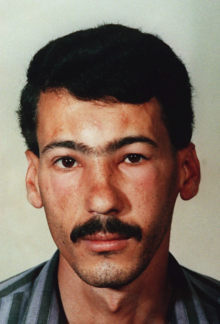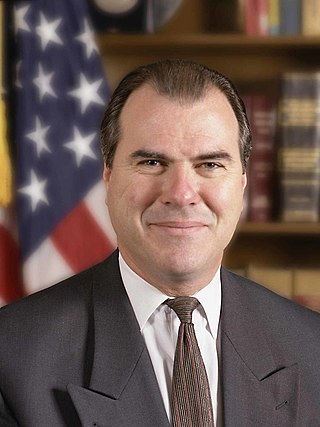
John Patrick O'Neill was an American counter-terrorism expert who worked as a special agent and eventually a Special Agent in Charge in the Federal Bureau of Investigation. In 1995, O'Neill began to intensely study the roots of the 1993 World Trade Center bombing after he assisted in the capture of Ramzi Yousef, who was the leader of that plot.

Ahmed Ressam, also known as the "Millennium Bomber", is an Algerian al-Qaeda member who lived for a time in Montreal, Quebec, Canada. He received extensive terrorist training in Afghanistan.
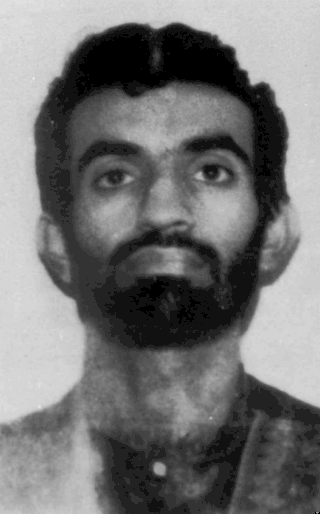
Ramzi Ahmed Yousef is a convicted terrorist who was one of the main perpetrators of the 1993 World Trade Center bombing and the bombing of Philippine Airlines Flight 434; he was also a co-conspirator in the Bojinka plot. In 1995, he was arrested by the Pakistani Inter-Services Intelligence (ISI) and U.S. Diplomatic Security Service at a guest house in Islamabad, Pakistan, while trying to set a bomb in a doll, then extradited to the United States.

The Bojinka plot was a large-scale, three-phase terrorist attack planned by Ramzi Yousef and Khalid Sheikh Mohammed for January 1995. They planned to assassinate Pope John Paul II; blow up 11 airliners in flight from Asia to the United States, with the goal of killing approximately 4,000 passengers and shutting down air travel around the world; and crash a plane into the headquarters of the United States Central Intelligence Agency (CIA) in Fairfax County, Virginia.
Abdul Hakim Ali Hashim Murad is a Pakistani Islamist terrorist, who was a co-conspirator in the Bojinka plot—the forerunner to the September 11 attacks. In 1996, he was convicted in the United States of trying to blow up a dozen airliners and was sentenced to life in prison.
Wali Khan Amin Shah is a Saudi man who fought with the Afghan Arabs in Afghanistan, and called for the jihad movement to focus on attacking the United States. He had a role in the foiled Bojinka plot. He was convicted of terrorism and imprisoned on these charges from 1995 to 2021.

Mohammed Jamal Khalifa (1 February 1957 – 31 January 2007) was a Saudi businessman from Jeddah who married one of Osama bin Laden's sisters. He has been accused of funding terror plots and groups in the Philippines in the 1990s while head of the International Islamic Relief Organization branch there. He was murdered in Madagascar in 2007.

Abdul Rahman Yasin is an Iraqi-American terrorist and fugitive who took part in the 1993 World Trade Center Bombing terrorist attack. Yasin is presumed to have helped make the bombs and explosives. He has been characterized in the American media as "the only participant in the first attempt to blow up the World Trade Center in 1993 who was never caught." Yasin's whereabouts remain unknown.
Laurie Mylroie is an American author and analyst who has written extensively on Iraq and the War on Terror. The National Interest first published this work in an article entitled, "The World Trade Center Bombing: Who is Ramzi Yousef? And Why it Matters." In her book Study of Revenge (2000), Mylroie laid out her argument that the Iraqi regime under Saddam Hussein had sponsored the 1993 World Trade Center bombing and subsequent terrorist attacks. She claimed those attacks were part of an ongoing war that Saddam waged against America following the cease-fire to the 1991 Gulf War. Less than a year after her book was published, the September 11 attacks occurred. Mylroie subsequently adopted the view that Saddam had been responsible for the attacks, defending it on many occasions, including before the 9/11 Commission.
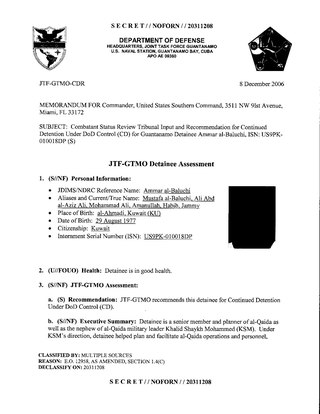
Ammar al-Baluchi or Amar al-Balochi is a Pakistani citizen who has been in American custody at the Guantánamo Bay detention camp since 2006. He was arrested in the Pakistani city of Karachi in 2003 before being transferred; the series of criminal charges against him include: "facilitating the 9/11 attackers, acting as a courier for Osama bin Laden and plotting to crash a plane packed with explosives into the U.S. consulate in Karachi." He is a nephew of the Pakistani terrorist Khalid Sheikh Mohammed, who served as a senior official of al-Qaeda between the late 1980s and early 2000s; and a cousin of the Pakistani terrorist Ramzi Ahmed Yousef, who played a key role in the 1993 World Trade Center bombing, the Philippine Airlines Flight 434 bombing, and the high-profile Bojinka plot.
On September 11, 2001, 19 al-Qaeda terrorists took control of four commercial aircraft and used them as suicide weapons in a series of four coordinated acts of terrorism to strike the World Trade Center in New York City, The Pentagon in Arlington County, Virginia, and an additional target in Washington, D.C. Two aircraft hit the World Trade Center while the third hit the Pentagon. A fourth plane did not arrive at its target, but crashed into a field in Pennsylvania after a passenger revolt. The intended target is believed to have been the United States Capitol. As a result, 2,977 victims were killed, making it the deadliest foreign attack on U.S. soil, exceeding Japan's surprise attack on Pearl Harbor in Honolulu, Hawaii, on December 7, 1941, which killed 2,335 members of the United States Armed Forces and 68 civilians. The effort was carefully planned by al-Qaeda, which sent 19 terrorists to take over Boeing 757 and Boeing 767 aircraft, operated by American Airlines and United Airlines.

Mahmud Abouhalima is an Egyptian citizen who is convicted as perpetrator of the 1993 World Trade Center bombing. He is currently serving a 67-year sentence at ADX Florence in Florence, Colorado for his role in the bombing.

Mohammed A. Salameh is a Palestinian convicted terrorist and perpetrator of the 1993 World Trade Center bombing. He is currently serving an unknown sentence as an inmate at FCI Terre Haute in Terre Haute, Indiana for taking part in the attack on New York.
Mehdat Abdul Salam Shabana was a member of the board of directors, during the mid-1990s, of the now defunct Konsojaya Trading Company, a terrorist front organization based in Kuala Lumpur, Malaysia. He owned half of the company's 6,000 shares. Konsojaya was a shell company cofounded by Riduan Isamuddin, better known as "Hambali", in June 1994. As of January 2002, Shabana's whereabouts were still unknown.

Mohammed Saddiq Odeh is a Saudi-born al-Qaeda member, sentenced in October 2001 to life imprisonment for his parts in the US embassy bombings in Kenya and Tanzania on August 7, 1998. Odeh was convicted along with three co-conspirators: Mohamed Rashed Daoud Al-Owhali, Khalfan Khamis Mohamed and Wadih el Hage. Another defendant, Ali Mohamed, pleaded guilty the previous year. Another, Mahdouh Salim, was awaiting trial, and three additional defendants were fighting extradition in England.

Eyad Ismoil is a Jordanian citizen who, for his role in the 1993 World Trade Center bombing, was convicted by the United States District Court for the Southern District of New York of conspiracy in 1997.

The Federal Investigation Agency is a border control, criminal investigation, counter-intelligence and security agency under the control of the Interior Secretary of Pakistan, tasked with investigative jurisdiction on undertaking operations against terrorism, espionage, federal crimes, smuggling as well as infringement and other specific crimes.
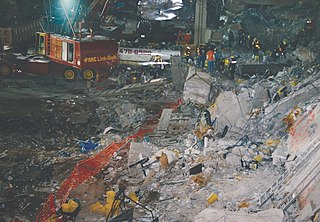
The 1993 World Trade Center bombing was a terrorist attack carried out on February 26, 1993, when a van bomb detonated below the North Tower of the World Trade Center complex in New York City. The 1,336 lb (606 kg) urea nitrate–hydrogen gas enhanced device was intended to send the North Tower crashing into its twin, the South Tower, taking down both skyscrapers and killing tens of thousands of people. While it failed to do so, it killed six people, including a pregnant woman, and caused over a thousand injuries. About 50,000 people were evacuated from the buildings that day.
On July 31, 1997, officers from the NYPD Emergency Service Unit raided an apartment in Brooklyn, New York City, after being warned of a planned bombing. Gazi Ibrahim Abu Mezer and Lafi Khalil, both Palestinian illegal immigrants were shot and apprehended during the raid, which located two pipe bombs in the apartment.

Nidal A. Ayyad is a convicted perpetrator of the 1993 World Trade Center bombing. He is currently serving an 86-year sentence at United States Penitentiary, Coleman for his role in the bombing.
